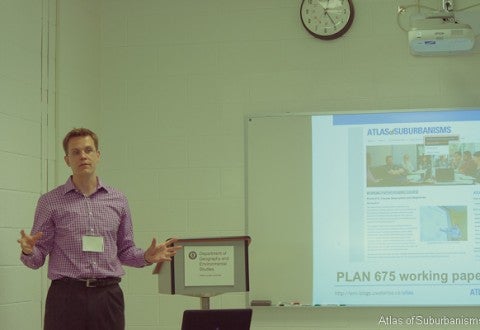Markus Moos on WNPR: Atlas of Suburbanisms featured on Where We Live “Suburbs 4.0”
Conneticut public radio calls on Markus Moos and the Atlas of Suburbanisms as part of a radio segment on the changing nature of the suburbs.
Conneticut public radio calls on Markus Moos and the Atlas of Suburbanisms as part of a radio segment on the changing nature of the suburbs.
A research team from the City-Region Studies Centre at the University of Alberta recently made use of Atlas of Suburbanisms maps as part of a design charette for the Strip Appeal urban design competition.
A team led by Professor David Gordon at Queen’s University estimates that up to two-thirds of Canadians may be living in suburban areas. They use Statistics Canada data to designate neighbourhoods as suburban or urban based on density and commuting patterns. Findings are presented in visually intriguing ways using a combination of census maps and Google Earth.
Professor John Lewis, School of Planning, led a guest lecture offering his take on the unique task of writing and publishing for private sector and political audiences, drawing on his own experiences as a consultant.
The Neighbourhood Change Research Group is hosting a panel event on the topic of urban inequality on July 4 in Toronto. Read for more info.
Glenn Miller hosts a guest lecture for the PLAN 675 Canadian Suburbanisms working papers reading course, drawing on 25 years of editorial insight offered up for discussion.
Links have been added to the Cultures of the Suburbs International Research Network project. Read more about this international collaboration and its contribution to the scholarly conversation about suburban development.
Roger Keil investigates the conceptualization of greenbelts as boundaries between the urban and suburban in an essay at the Global Suburbanisms project website.
A recent Insight report “Boomtown in the Backyard – Suburban Growth in Ontario” from the Martin Prosperity Institute features the work of School of Planning scholars in examining the growth patterns of what many would consider traditional suburbs. Alongside the written analysis is the use of dot-density maps to visually represent population distribution across Ontario’s cities.

The Atlas of Suburbanisms officially launched to a full house at a lunch time session as part of the 2012 CAG Annual Meeting. Read more to see photos of the session and tweets about the launch.